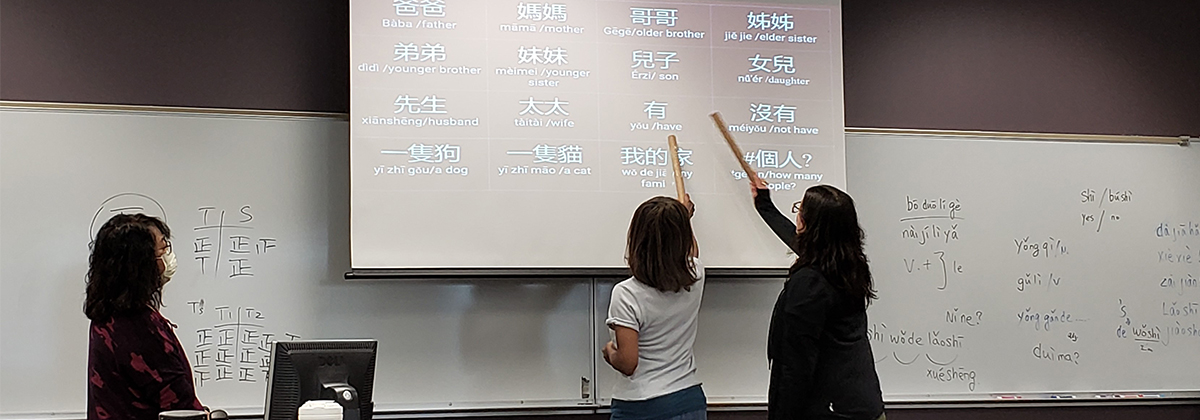- Educational Technology, Research and Assessment
- Project SEED
- Training and Orientation
Training and Orientation

Orientation Sessions Schedule
- Session 1: Welcome orientation
- Session 2: Project SEED orientation
- Session 3: Orientation on research goals
- Session 4: Orientation on research methods
- Session 5: Orientation on Taiwan's twelve-year curriculum and national civic literacy survey research initiative
- Session 6: Orientation on curriculum development theory and practice
- Session 7: Travel preparation orientation
Modern Mandarin Chinese for Education
Course Overview
This course introduced standard, modern Mandarin Chinese for education including pronunciation, idiomatic expressions, speech patterns and daily conversational phrases for the beginning to intermediate student. Students learned basic vocabulary and sentence structures for use in essential everyday situations through various forms of oral practice. Students learned Pinyin (as a tool to learn how to speak the language) and Chinese characters (approximately 100 words) and expressions in order to be able to communicate effectively in real Chinese situations. While the linguistic aspects of the Chinese language were the primary focus, introduction to the social and cultural background of the language was also an important component of the course.
Weekly Schedule
| Date | Content |
|---|---|
| Week 1 Online-Async |
Introduction/greeting Pinyin and writing system Formal and casual self-introduction |
| Week 2 Face-to-face |
Nationalities and Food (simulation activities) |
| Week 3 Online-Async |
Color; Number and Family (talking about colors, money and numbers) |
| Week 4 Face-to-face |
Hobbies/things like and dislike (simulation activities) |
| Week 5 Online-Async |
What's Authentic Food? Talking about food and placing order |
| Week 6 Online-Async |
Cultural etiquette/don't make cultural etiquette mistakes Night market (simulation activities) |
| Week 7 Face-to-face |
Transportation/Asking the way Buying things |
| Week 8 Face-to-face |
Ordering food/dining simulation |
| Week 9 Face-to-face |
Performance Assessment |
Highlights from the Course
Week 1-2
Participants were introduced to the basics of Mandarin language, such as Pinyin (phonetic system), tones, and pronouns. Participants learned and orally practiced formal and casual self-introductions that included basic greetings and their nationality. The latter part of this class introduced participants to Chinese calligraphy art paintings to present the aspect of the Mandarin writing system in which characters are written in a vertical fashion. Participants used a brush and ink to create a painting and sign their names in Mandarin characters vertically as a seal.
Week 3-4
Lessons covered topics such as different ways to ask questions or ask for things relevant to everyday situations, colors, hobbies, numbers, and money. Participants practiced exchanging greetings and responses, incorporating the topics that were covered in these lessons. Participants were then introduced to a traditional Chinese method of painting called ink blowing, which simply involved placing a drop or two of ink on a piece of paper and blowing while controlling their breath until the desired outline was achieved. The subject of the painting was blue and white porcelain, which was presented to have cultural and social significance in Asian history.
Week 5-7
Covered lessons in grammar topics (e.g., using particle and measure words to describe members of the family) and concepts relevant to daily life (e.g., date, time, ordering food, asking/giving directions, buying things). Participants practiced mastering their knowledge through various review activities that consisted of listening, recognizing, and speaking in Mandarin. Practical activities of language communication enhanced participants' understanding of Taiwanese culture and customs.
Week 8
This week consisted of review activities and covered the expectations for the summative assessment presentation. At this point of the course, participants understood essential vocabulary and basic grammatical structure of the language and had basic communication skills in Mandarin Chinese. The review activities further developed participants' listening and speaking skills through extensive exchanges. As an extension activity of learning the colors, participants created colorful, vibrant paintings on canvas, with themes of Tree of Life or Tropical Garden.
Week 9
The last day of the course consisted of review/reflection of course, exposure to Taiwanese cultural activities, performance assessment (presentations) and completion of course ceremony. Cultural topics presented were the school system in Taiwan (and how it differed from the U.S.) and cultural activities that Taiwanese participated in (e.g., spinning a cloth and Chinese yo-yo/diabolo). Participants learned that the cultural significance of the acrobatic activities was their integration into early childhood Taiwanese education.
Participants gave a final presentation to demonstrate mastery of course content. A ceremony was held in which participants received a certificate of completion.
Contact Us
Educational Technology, Research and Assessment
Gabel Hall 208
DeKalb, IL 60115
815-753-9339
815-753-9388 (fax)
etra@niu.edu